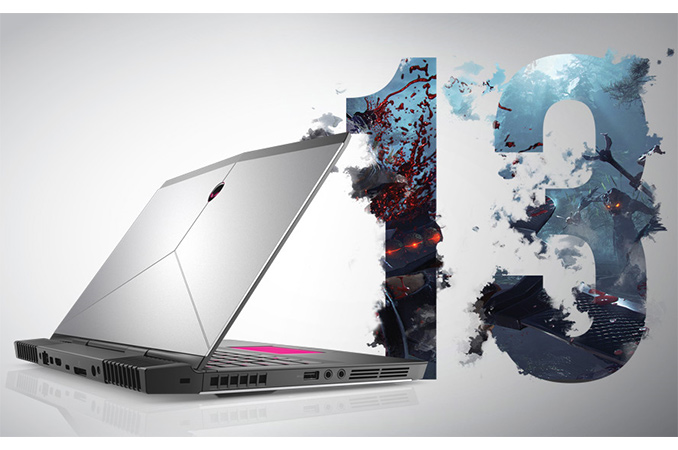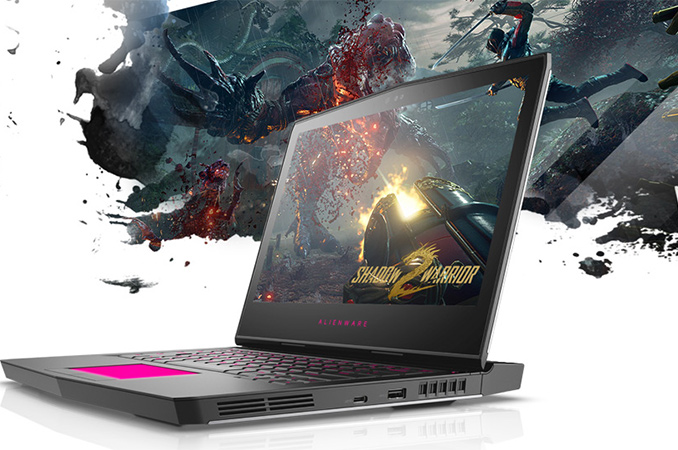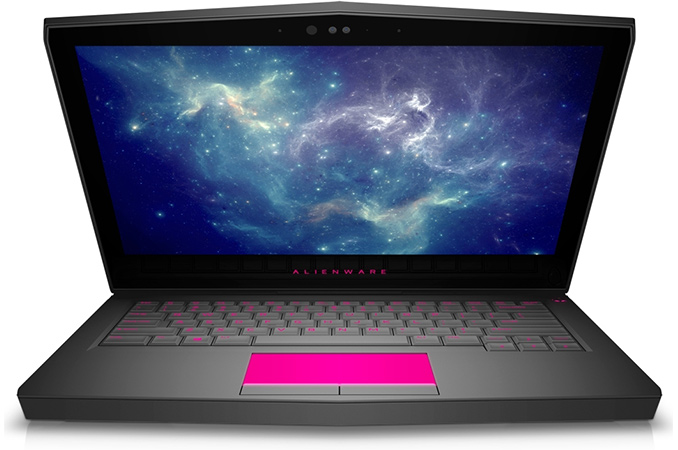Alienware 13 R3: Quad-Core CPU, GeForce GTX 1060, QHD OLED, VR Ready
by Anton Shilov on November 10, 2016 2:00 PM EST
Alienware last week introduced the third generation of its 13” gaming notebooks. The manufacturer describes its new Alienware 13 R3 machines as the world’s first 13-inch laptops capable of handling VR workloads and equips them with appropriate hardware, such as quad-core Intel Core CPU, NVIDIA’s GeForce GTX 1060 GPU, high-end SSDs and the appropriate ports. To appeal to traditional gamers, Alienware also offers an optional QHD OLED display with its 13” notebooks.
Dell’s boutique PC division introduced its first 13” gaming laptop, the Alienware 13, in late 2014. While the system was relatively powerful, its performance was not maxed out (a dual-core CPU, a low-end GPU, and an HDD in an entry-level configuration) and its key selling point was support for the Graphics Amplifier, an external box for video cards. The second-generation Alienware 13 released in 2015 got considerably faster graphics, but it still used dual-core CPUs, which can provide insufficient performance for come games. The manufacturer decided to improve the performance density of its third-generation compact gaming notebook significantly, which is why the Alienware 13 R3 comes with a quad-core Intel Core i5/i7 CPU and a rather powerful 16nm GPU. Moreover, the key selling point of the PC is not its eGFX support (it is still supported), but compliance with minimum requirements for VR gaming set by Oculus VR.
Alienware offers four Alienware 13 R3 models based on the 45W Intel Core i5-6300HQ or the 45W Intel Core i7-6700HQ and all models will feature NVIDIA’s GeForce GTX 1060 GPU with 6 GB of GDDR5 memory. The systems come equipped with 8 or 16 GB of DDR4 SDRAM (upgradeable to 32 GB), one or two SATA or PCIe SSDs (upgradeable to 2 TB of storage), Rivet Networks' Killer 1435 802.11ac 2×2 WiFi + Bluetooth 4.1 and E2400 GbE controllers, an HD webcam with IR presence detection and so on. On the connectivity front, the Alienware 13 R3 supports Thunderbolt 3, USB-A, USB-C, mDP 1.2, HDMI 2.0 ports, 3.5 mm audio jacks as well as a Graphics Amplifier port. To further appeal to gamers, the Alienware 13 R3 has improved audio sub-systems (with larger speaker boxes), a TactX keyboard with n-key rollover and 'optimized key shape' as well as AlienFX lighting that uses fiber-optic guides.
| Alienware 13 R3 (2016) | |||||
| i5-6300 HQ dkcwe01h |
i5-6300 HQ dkcwe02h |
i7-6700 HQ dkcwe03h |
i7-6700 HQ dkcwe04h |
||
| CPU | Intel Core i5-6300HQ 4C/4T 2.30/3.20 GHz 6 MB LLC HD Graphics 530 45 W |
Intel Core i7-6700HQ 4C/8T 2.60/3.50 GHz 6 MB LLC HD Graphics 530 45 W |
|||
| dGPU | NVIDIA GeForce GTX 1060 6 GB of GDDR5 at 8 GT/s 1280 SPs 80 texture units 48 ROPs 192-bit memory bus |
||||
| DRAM | Installed | 8 GB DDR4-2133 (8 GB × 1) |
16 GB DDR4-2133 (8 GB × 2) |
8 GB DDR4-2400 (8 GB × 1) |
8 GB DDR4-2400 (8 GB × 1) |
| Upgradeable | 32 GB DDR4-2133 (16 GB × 2) |
32 GB DDR4-2400 (16 GB × 2) |
32 GB DDR4-2400 (16 GB × 2) |
32 GB DDR4-2400 (16 GB × 2) |
|
| Display | Type | TN | IPS | OLED | OLED |
| Resolution | 1366×768 | 1920×1080 | 2560×1440 | ||
| Brightness | 200 cd/m² | 300 cd/m² | 400 cd/m² | ||
| Contrast | unknown | 100,000:1 | |||
| Touch | - | + | |||
| Storage (2x M.2) |
Installed | 180 GB SATA | 256 GB PCIe | 512 GB PCIe | |
| Upgradeable | 1 TB PCIe + 1 TB PCIe SSD | ||||
| Battery | 76 Wh | ||||
| Wireless Connectivity | Rivet Networks Killer 1435 802.11ac 2×2 WiFi + Bluetooth 4.1 |
||||
| Ports | Thunderbolt 3 × 1 (Type-C) USB 3.1 × 1 (Type-C) USB 3.0 × 2 (Type A) GbE × 1 (Killer E2400) mDP 1.2 × 1 HDMI 2.0 × 1 3.5 mm audio × 2 Graphics Amplifier × 1 |
||||
| Camera | Windows Hello Tobii Eye Tracking |
||||
| Dimensions | 390 × 259 × 23.3 mm 15.35 × 10.2 × 0.92 inches |
||||
| Weight | 2 kg 5 lbs |
||||
| Price | $1200 | $1500 | $1800 | $2100 | |
From a performance point of view, the Alienware 13 R3 meets the minimum requirements set by Oculus VR for games compatible with the Oculus Rift VR headset. However it's worth noting from a connectivity point of view that not everything is simple. The system only has two USB Type-A ports, whereas the Oculus VR headset needs three USB 3.0 ports and one USB 2.0 for Xbox One controller. This would suggest the need for USB hubs (or USB ports on the Graphics Amplifier — it has four of them).
A note on the camera - Dell actively promotes both the use of a Windows Hello capable camera system (presumably using Intel's RealSense) as well as the integration of Tobii's eye-tracking software. Up until this implementation we had seen Tobii's eye-tracking implementation using special sensors, but it sounds as if the R13 can still do this with the Windows Hello capable system. We would imagine that it might not be as accurate, or be more computationally expensive, but it can be an interesting feature nonetheless.
Up next are displays. The configurations featuring Intel Core i5 CPUs come with a TN HD (1366×768) or a touch-sensing IPS FHD (1920×1080) panel. Meanwhile, the Core i7-based laptops can boast with QHD OLED panels (2560×1440) with touch support, 400 nits brightness and 100,000:1 contrast. All Alienware 13 R3 notebooks are equipped with a 76 Wh lithium-ion battery (up from 51 Wh inside the A13 R2), but the supplier did not mention battery life of different configurations.
The new Alienware 13 R3 laptops are already available in the U.S. They will hit Europe next week and China later this month. The most affordable version (Core i5-6300HQ, GeForce GTX 1060, 8 GB RAM, 180 GB SSD, HD TN display, etc.) costs $1200, whereas the premium model (Core i7-6700HQ, GeForce GTX 1060, 16 GB RAM, 512 GB PCIe SSD, QHD OLED display, etc.) is available for $2100. All configurations of the Alienware 13 R3 can be customized to better meet the needs of their owners. Moreover, since the A13 R3 laptops support external graphics (there is no word whether they support TB3-based eGFX or have to use the Graphics Amplifier exclusively), they can be upgraded over time.
Related Reading:
Source: Alienware
















45 Comments
View All Comments
cknobman - Thursday, November 10, 2016 - link
Tough call between this and a Razer Blade.In the end I think I would go with a similar spec'd Razer Blade.
RaichuPls - Thursday, November 10, 2016 - link
Razer Blade is more expensive though. I think it's $2499 for the 512GB QHD+ model that isn't even full 4K?Samus - Friday, November 11, 2016 - link
The $1500 configuration of this is around $300 cheaper than the same configuration of the Razer Blade.And it's probably worth pointing out to those that don't know...Alienware products hold their value quite well because they are reliable and the support is good. Razer on the other hand can't even support or fix numerous issues with their products, let alone the Blade. I know a lot of people think of them as the OCZ of accessories. The Lycosa gaming keyboard is a good example why.
Wolfpup - Friday, November 11, 2016 - link
I've had two Alienware systems so far, and both have been rock solid after years of use, and both support Nvidia's normal drivers (and the notebook which has Optimus has it OPTIONAL, so I could disable it as soon as it started causing problems in games).I really don't care how thick a notebook is or what it looks like...I want it to be well speced, well cooled, and reliable, and so far at least with the Alienware stuff I've bought it has been (not that every system they've done has been perfect, but I've lucked out so far).
trulyuncouth - Monday, November 14, 2016 - link
I've had 3 alienwares and a VERY different experience. The only one I had no issues with was the 11.6" laptop they sold a bit back.More recently I got a 17" with the 980. It has been nothing but trouble. First the 980 only outputs through the onboard graphics making it not function at 4k60fps, even though the main graphics card is capable.
The mainboard failed in it, as did the memory. I am now just outside of warranty and the damn thing stopped booting, instead beeping multiple times without the screen ever coming on. A $2000 laptop and it has been nothing but a nightmare. I will never buy an alienware again.
RaichuPls - Saturday, November 12, 2016 - link
There's also the MSI GS43VR that's $1499 for 6700HQ, GTX 1060, 16GB RAM and 1080p IPS too.Morawka - Thursday, November 10, 2016 - link
no GPU, going right back to a 25w dual core cpu as well, and slower memory to boot.ragenalien - Thursday, November 10, 2016 - link
That's the Razer blade stealth. The Blade 14 has similar spec to this alienware.Freakie - Thursday, November 10, 2016 - link
If you want portability, go with the Razer Blade, at least until the Gigabyte Aero 14 comes out with it's 1060 update. If you don't mind the bulk that this Alienware has, the Gigabyte P35X v6 is a good option too.Wolfpup - Friday, November 11, 2016 - link
I don't see how ANY notebook is any more portable than any other notebook. I can't fit a Macbook in my pocket, it has to go in my bag, and at that point it doesn't make a bit of difference if I'm using a 2" thick 18.4" notebook or a razor thin 12" one.